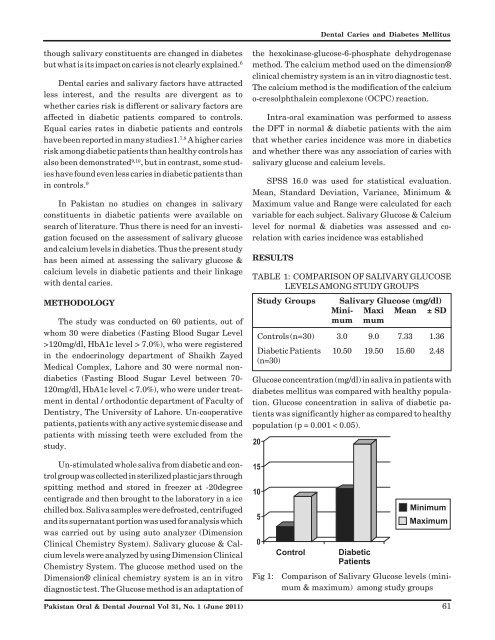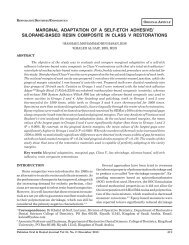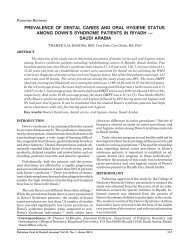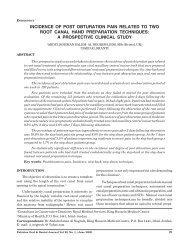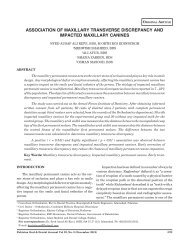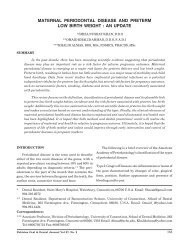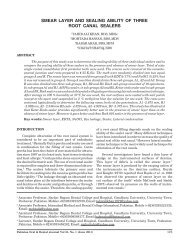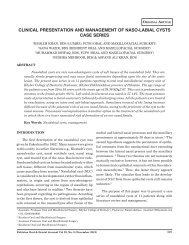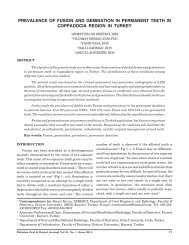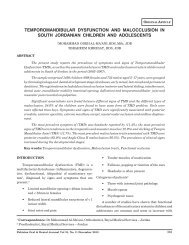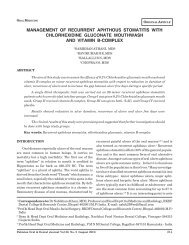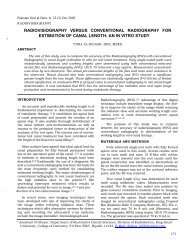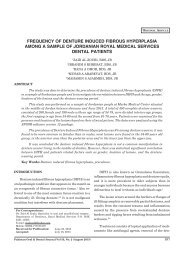Dental caries & diabetes mellitus - Pakistan Oral and Dental Journal ...
Dental caries & diabetes mellitus - Pakistan Oral and Dental Journal ...
Dental caries & diabetes mellitus - Pakistan Oral and Dental Journal ...
Create successful ePaper yourself
Turn your PDF publications into a flip-book with our unique Google optimized e-Paper software.
<strong>Dental</strong> Caries <strong>and</strong> Diabetes Mellitusthough salivary constituents are changed in <strong>diabetes</strong>but what is its impact on <strong>caries</strong> is not clearly explained. 6<strong>Dental</strong> <strong>caries</strong> <strong>and</strong> salivary factors have attractedless interest, <strong>and</strong> the results are divergent as towhether <strong>caries</strong> risk is different or salivary factors areaffected in diabetic patients compared to controls.Equal <strong>caries</strong> rates in diabetic patients <strong>and</strong> controlshave been reported in many studies1. 7,8 A higher <strong>caries</strong>risk among diabetic patients than healthy controls hasalso been demonstrated 9,10 , but in contrast, some studieshave found even less <strong>caries</strong> in diabetic patients thanin controls. 9In <strong>Pakistan</strong> no studies on changes in salivaryconstituents in diabetic patients were available onsearch of literature. Thus there is need for an investigationfocused on the assessment of salivary glucose<strong>and</strong> calcium levels in diabetics. Thus the present studyhas been aimed at assessing the salivary glucose &calcium levels in diabetic patients <strong>and</strong> their linkagewith dental <strong>caries</strong>.METHODOLOGYThe study was conducted on 60 patients, out ofwhom 30 were diabetics (Fasting Blood Sugar Level>120mg/dl, HbA1c level > 7.0%), who were registeredin the endocrinology department of Shaikh ZayedMedical Complex, Lahore <strong>and</strong> 30 were normal nondiabetics(Fasting Blood Sugar Level between 70-120mg/dl, HbA1c level < 7.0%), who were under treatmentin dental / orthodontic department of Faculty ofDentistry, The University of Lahore. Un-cooperativepatients, patients with any active systemic disease <strong>and</strong>patients with missing teeth were excluded from thestudy.the hexokinase-glucose-6-phosphate dehydrogenasemethod. The calcium method used on the dimension®clinical chemistry system is an in vitro diagnostic test.The calcium method is the modification of the calciumo-cresolphthalein complexone (OCPC) reaction.Intra-oral examination was performed to assessthe DFT in normal & diabetic patients with the aimthat whether <strong>caries</strong> incidence was more in diabetics<strong>and</strong> whether there was any association of <strong>caries</strong> withsalivary glucose <strong>and</strong> calcium levels.SPSS 16.0 was used for statistical evaluation.Mean, St<strong>and</strong>ard Deviation, Variance, Minimum &Maximum value <strong>and</strong> Range were calculated for eachvariable for each subject. Salivary Glucose & Calciumlevel for normal & diabetics was assessed <strong>and</strong> corelationwith <strong>caries</strong> incidence was establishedRESULTSTABLE 1: COMPARISON OF SALIVARY GLUCOSELEVELS AMONG STUDY GROUPSStudy Groups Salivary Glucose (mg/dl)Mini- Maxi Mean ± SDmum mumControls (n=30) 3.0 9.0 7.33 1.36Diabetic Patients 10.50 19.50 15.60 2.48(n=30)Glucose concentration (mg/dl) in saliva in patients with<strong>diabetes</strong> <strong>mellitus</strong> was compared with healthy population.Glucose concentration in saliva of diabetic patientswas significantly higher as compared to healthypopulation (p = 0.001 < 0.05).Un-stimulated whole saliva from diabetic <strong>and</strong> controlgroup was collected in sterilized plastic jars throughspitting method <strong>and</strong> stored in freezer at -20degreecentigrade <strong>and</strong> then brought to the laboratory in a icechilled box. Saliva samples were defrosted, centrifuged<strong>and</strong> its supernatant portion was used for analysis whichwas carried out by using auto analyzer (DimensionClinical Chemistry System). Salivary glucose & Calciumlevels were analyzed by using Dimension ClinicalChemistry System. The glucose method used on theDimension® clinical chemistry system is an in vitrodiagnostic test. The Glucose method is an adaptation of<strong>Pakistan</strong> <strong>Oral</strong> & <strong>Dental</strong> <strong>Journal</strong> Vol 31, No. 1 (June 2011)Fig 1:Comparison of Salivary Glucose levels (minimum& maximum) among study groups61


